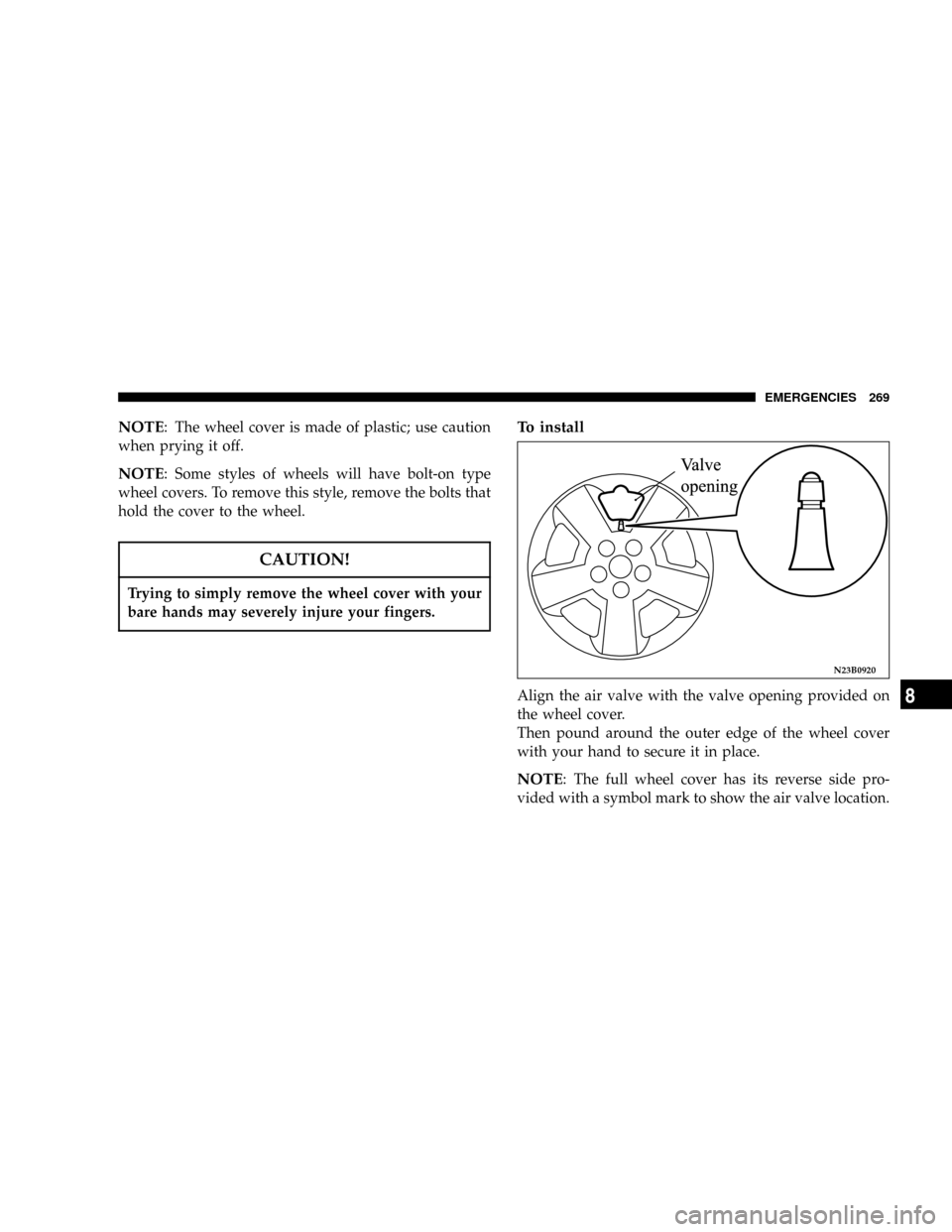DODGE STRATUS COUPE 2005 2.G Owners Manual
Manufacturer: DODGE, Model Year: 2005, Model line: STRATUS COUPE, Model: DODGE STRATUS COUPE 2005 2.GPages: 396
Page 261 of 396

EMERGENCIES
CONTENTS
mIf the vehicle breaks down................263
NIf the engine quits.....................263
mOperation under adverse driving conditions...263
NIf your vehicle becomes stuck in sand, mud or
snow..............................263
NOnawetroad........................264
NOn snowy or icy roads..................265
mSpare tire, jack and tool set storage.........266
NHandling spare tire....................266
NJack...............................267
mCompact spare tire.....................267
mWheel covers (if so equipped).............268
mJacking and tire changing................270
NJacking up the vehicle..................270
mEngine overheating.....................279
mJump-starting the engine.................280
NIf your vehicle has anti-lock brakes.........284
mTowing..............................284
mFuses...............................286
NFuse block...........................287
mFusible links..........................287
NFuse load capacities....................288
mReplacement of light bulbs................293
NBulb capacity.........................293
8
Page 262 of 396

NHeadlights..........................295
NAdjustment of headlight aim..............297
NFront turn signal and parking lights.........297
NFront fog lights (if so equipped)...........298
NFront side marker lights.................300NRear combination lights.................301
NHigh-mounted stop light................302
NLicense plate light.....................303
NBack up lights........................303
NDome light..........................306
262 EMERGENCIES
Page 263 of 396

IF THE VEHICLE BREAKS DOWN
If the vehicle breaks down on the road, move to the
shoulder and activate the hazard warning flashers. If
there is no shoulder, or the shoulder is not safe, drive in
the right lane, slowly, with the hazard flashers activated,
until you reach a safe place to stop. Keep the flashers
activated.
If the engine quits
If the engine stops, power will be lost to the steering and
brakes, making steering and braking difficult.
1. The brake booster becomes inoperative and the brake
pedal will be harder to push than usual.
2. Since power steering system is not operative, the
steering wheel will be stiff when turning. Turn the wheel
with more effort than usual.
OPERATION UNDER ADVERSE DRIVING
CONDITIONS
If your vehicle becomes stuck in sand, mud or
snow
If the vehicle becomes stuck in snow, sand, or mud, it can
often be moved by a rocking motion. Turn your steering
wheel right and left to clear the area around the wheels.
Move the gearshift lever or selector lever rhythmically
between the 1st and REVERSE position (with manual
transaxle), ``L'' (Low) and ``R'' (REVERSE) position (with
automatic transaxle), Autostick and ``R'' (REVERSE posi-
tion (with automatic transaxle autostick), while applying
slight pressure to the accelerator pedal.
Avoid racing the engine or spinning the wheels. Pro-
longed efforts to free a stuck vehicle may result in
overheating and transaxle failure.
Allow the engine to idle for a few minutes to let the
transaxle cool between rocking attempts.
If the vehicle remains stuck after several rocking at-
tempts, seek other assistance.
EMERGENCIES 263
8
Page 264 of 396

WARNING!
When attempting to rock your vehicle out of a stuck
position, be sure that the area around the vehicle is
clear of people. The rocking motion may cause the
vehicle to suddenly lurch forward or backward,
causing injury to by-standers.
On a wet road
CAUTION!
²Avoid flooded roads. Water depth can be decep-
tive, and you could be seriously hurt by driving
into flood water.
²When driving in rain, on water-covered roads, or
through a vehicle wash, water could enter the
brake drum linings or discs, resulting in tempo-
rarily ineffective brakes. In such cases, lightly
depress the brake pedal to see if the brakes
operate properly. If they do not, lightly depress
the pedal several times while driving in order to
dry the brake pads or linings, then check them
again.
264 EMERGENCIES
Page 265 of 396

CAUTION!
²When driving in rain, a layer of water may form
between the tires and the road surface (hydroplan-
ing).
This reduces a tire's frictional resistance on the
road, resulting in loss of steering stability and
braking capability. When driving on a wet road,
observe the following:
(a) Drive your vehicle at a safe speed.
(b) Do not drive on worn tires.
(c) Always maintain the specified tire inflation
pressures.
On snowy or icy roads
1. When driving on a road covered by snow or ice, it is
recommended that you use snow tires.
CAUTION!
Tire chains are not recommended for your vehicle.
The clearance between the chains and the body is
small, and body damage may occur.
2. Drive slowly. Avoid any sudden starts or stops, abrupt
brake application or sharp cornering.
3. Depressing the brake pedal during travel on snowy or
icy roads may cause tire slippage and skidding. When a
skid occurs, take your foot off the accelerator. Steer gently
into the skid. Braking will differ, depending upon
whether you have anti-lock brakes (ABS). If you do have
ABS, brake by pressing the brake pedal firmly, and
keeping it pressed. If you do not have ABS (vehicles
without anti-lock braking system) pump the brake pedal
with short rapid jabs, each time fully applying and fully
releasing for greatest effect.
4. Allow extra distance between your vehicle and the
vehicle in front of you, and avoid sudden braking.
EMERGENCIES 265
8
Page 266 of 396

SPARE TIRE, JACK AND TOOL SET STORAGE
The spare tire, jack and tool set are stowed in the trunk.
Handling spare tire
Remove the installation clamp to remove the spare tire.
To install the spare tire, tighten the clamp firmly with
your fingers until the spare tire has no more play.
N01A1180
Tool setJack
N03A1870
Clamp Loosen
266 EMERGENCIES
Page 267 of 396

Jack
To remove
Turn the shaft end so that the jack contracts and detach it
from the storage bracket.
To store
Turn the shaft end by hand to expand the jack until it is
secured firmly in position.
COMPACT SPARE TIRE
The compact spare tire is designed to save space in the
trunk and its lighter weight makes it easier to use if a flat
tire occurs.
CAUTION!
²The tire pressure should be periodically checked
and maintained at the specified pressure while
the tire is stowed.
²Driving with an insufficient tire pressure can lead
to an accident. If you have no choice but to drive
with an insufficient tire pressure, keep your speed
down and adjust to the specified pressure [60 psi
(420 kPa)] as soon as possible.
²The compact spare should only be used temporarily
and should be returned to the trunk and the
original
tire repaired or replaced as soon as possible. If your
vehicle is equipped with aluminum type wheels, the
wheel nuts for aluminum type wheels can be used
temporarily on the compact spare tire wheel.
²Do not exceed 50 mph (80 km/h) while the com-
pact spare tire is installed on the vehicle.
N21C0010To removeTo storeStorage
bracket
EMERGENCIES 267
8
Page 268 of 396

CAUTION!
²Avoid rapid starting and braking with a compact
spare tire.
²Avoid driving through automatic vehicle washes
and over obstacles that could possibly damage the
vehicle's under-carriage. Because the tire is
smaller than the original tire, vehicle ground
clearance is slightly reduced.
²As the compact spare tire is specifically designed
for your vehicle, it should not be used on any
other vehicle.
²The compact spare tire should not be used on any
other wheels, nor should standard tires, snow tires,
wheel covers or trim rings be used with the compact
spare wheel. If such use is attempted, damage to
these items or other vehicle components may occur.
²Do not use snow chains with your compact spare
tire. Because of the smaller tire size, a snow chain
will not fit properly. This could cause damage to
the vehicle and could result in loss of the chains.
²The compact spare tire pressure should be
checked once a month while the tire is stowed.
WHEEL COVERS (IF SO EQUIPPED)
To remove
Wrap the tip of the bar with a cloth, insert it deeply into
the notch provided in the wheel cover, and pry the cover
away from the wheel.
Using the same procedure on the other side, work the
wheel cover away from the wheel to remove it com-
pletely.
N23B0630
268 EMERGENCIES
Page 269 of 396

NOTE: The wheel cover is made of plastic; use caution
when prying it off.
NOTE: Some styles of wheels will have bolt-on type
wheel covers. To remove this style, remove the bolts that
hold the cover to the wheel.
CAUTION!
Trying to simply remove the wheel cover with your
bare hands may severely injure your fingers.
To install
Align the air valve with the valve opening provided on
the wheel cover.
Then pound around the outer edge of the wheel cover
with your hand to secure it in place.
NOTE: The full wheel cover has its reverse side pro-
vided with a symbol mark to show the air valve location.
N23B0920
EMERGENCIES 269
8
Page 270 of 396

Before installing the wheel cover to the wheel, make sure
that the opening with the symbol mark is correctly
aligned with the air valve.
JACKING AND TIRE CHANGING
If a tire must be changed, do so only after making sure
the vehicle is stopped in a safe, flat location.
Jacking up the vehicle
1. Park the vehicle on level and stable ground.
2. Switch on the hazard warning flashers, set up a
warning triangle, flashing signal light, etc., at an ad-
equate distance from the vehicle, and have all passengers
leave the vehicle. Turn the ignition key to the ªLOCKº
position.
3. Set the parking brake firmly, and move the gearshift
lever (manual transaxle) to the ªNº (Neutral) position or
move the selector lever (automatic transaxle) to the ªPº
(PARK) position.4. Apply a chock or block (A) at the tire diagonally
opposite the tire (B) to be changed.
NOTE: The chock shown is not supplied with the ve-
hicle. It is recommended that you keep one in the vehicle
for use if required.
N24A0100
A
B
270 EMERGENCIES